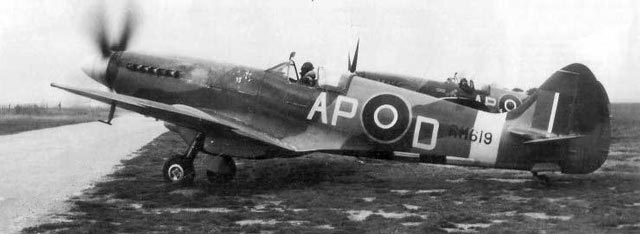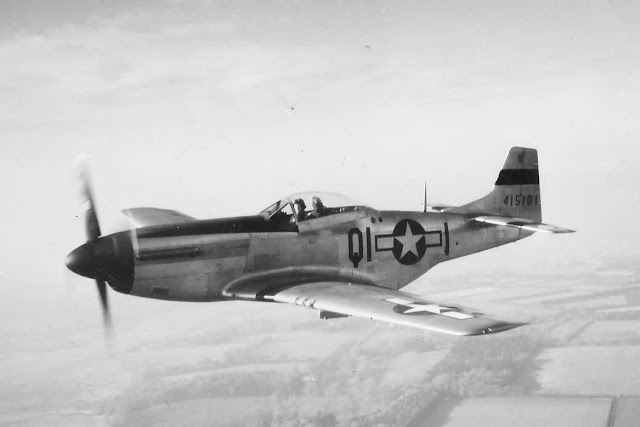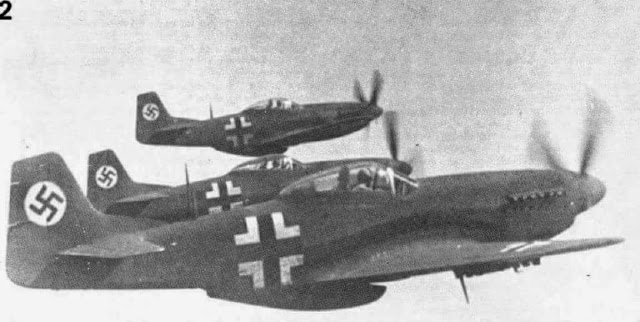Two of the Best Fighters of World War II
 |
| P-51D Mustang and Supermarine Spitfire FR Mk.XIVe. |
There are inevitable definitional problems to questions such as “which warplane was better.” The main obstacle in a question like this is that there almost always were many different versions of the same plane flying at the same time. They did not have the same performance characteristics because some represented upgrades, others were modified for different roles, and some were variants of the model. What armament a particular plane carried affected its speed and performance, but heavier armament could make a plane more effective despite the performance drag. Simply comparing numbers is dangerous in this area when all planes under consideration were fast enough and well-enough armed to do their jobs.
Just to give some examples of what I mean, the MK XVIII (Type 394) Spitfire was a further refinement of the Mk. XIV but never became operational. The P-51 is treated the same way. Post-war Mustang models such as the F-51H were not even used in Korea. I ignore situations like that.
So, here's how we are going to address this. If you were a Luftwaffe pilot and saw a typical plane below you in December 1944, what could you expect? That's what we are looking at here.
Let's look at the Spitfires first.
 |
| A Spitfire Mk. XIV. |
The Supermarine Spitfire Mk XIV
Supermarine Spitfires were continually upgraded and had different characteristics by the end of World War II. So, this is difficult to talk about Spitfires because it depends on which Spitfire you are referring to as you get deeper into World War II.For instance, there was the Mk XVI (type 361). A total of 1,054 Mk XVI Spitfires were built at Castle Bromwich and delivered for service beginning in October 1944. They saw action with the RAF’s 2nd Tactical Air Force in a ground-attack role. The Mk XVI had a Merlin 266 engine, which was the Merlin 66 built under license in the USA by the Packard Motor Company.
 |
| A late-war Spitfire. Note the five propeller blades. |
 |
| Spitfire Mk. XIV. |
The Mk XIV could climb to 20,000 ft (6,100 m) in just over five minutes. It had a top speed (at 25,400 ft (7,700 m)) of 446 mph (718 km/h). The appearance of the Mk XIV was distinctive because it used a five bladed Rotol propeller of 10 ft 5 in (3.18 m) in diameter. The plane was considered difficult to handle but could climb like a beast.
 |
| P-51D Mustang 44-15101 of the 356th Fighter Group, 361 Fighter Squadron in flight during World War II. |
The P-51D
Now, let’s turn to the North American P-51. There were 6,502 of these built at Inglewood and 1,600 at Dallas - a combined total of 8,102. These planes remained in service long after World War II, so pinning down exactly what they were capable of doing during the war and not just afterward is important. Fortunately, the primary model is easy to pinpoint: the P-51D (the P-51K was similar for all intents and purposes but was made just in Dallas; it differed only by having an inferior propeller).North American Aviation's P-51D was the mainstay of the USAAF presence in the European Theater of Operations (ETO). This model entered service in mid-1944 (in March and later), but earlier versions also remained in service to the end of the war (P-51Ds never exceeded more than half of the total Mustangs being flown in the ETO). Thus, you might see vastly different performances by two Mustangs flying side-by-side depending on what models they were. The P-51D was powered by the Packard (Rolls Royce Merlin) V-1650-7 (1,695 hp), a license-built version of the two-speed two-stage-supercharged Merlin 66.
 |
| A World War II photo of a P-51 clearly showing the 85-gallon (322 liters) drop tank which vastly expanded their effectiveness. |
 |
| A Royal Canadian Air Force Spitfire Mk. XIV showing signs of wear. |
Comparison
The late-war Spitfires were slightly faster than the P-51D Mustangs by less than 10 mph. This was achieved by using engines that consumed fuel faster and thus gave the Spitfire a dramatically lower range than the Mustang.The top Luftwaffe pilots who observed both planes passed their judgment as to which was a more difficult competitor. Fighter ace Heinz Bär, who flew over 1000 combat missions, was credited with 208 planes shot down (he claimed 228). This included16 planes shot down while flying in the ME 262 jet fighter. His 124 victories against the Western Allies were second only to Hans-Joachim Marseille's total of 158.
Bär favored the P-51D. He said that the P-51 "was perhaps the most difficult of all Allied aircraft to meet in combat. It was fast, maneuverable, hard to see, and difficult to identify because it resembled the Me 109."
 |
| Spitfire Mk XIV XC-S of No. 26 Squadron RAF in flight. |
The cockpits of all of these enemy aircraft were much more comfortable. You could not fly the Bf-109 for seven hours; the cockpit was too tight, too narrow. The P-51 (cockpit) was for me a great room, just fantastic. The P-38 with two engines was great, but I think the best airplane was the P-51. Certainly, the Spitfire was excellent, but it didn’t have the endurance of the P-51. I think this was the decisive factor. They flew for seven hours, and we flew for one hour and 20 minutes.The Bf-109 and the Spitfire had roughly the same amount of endurance. The P-51s were considered particularly durable aircraft both in terms of flight time and airframe strength.
Now the big thing in the Home Defense as far as problems was the P-51. The P-51 was a damned good airplane and it had tremendous endurance, which for us was a new dimension. The P-47, which as you know shot me down, we knew right away. It had tremendous diving speed and could run up to 1,400 kilometers per hour, where the Bf-109 was limited to 1,000 kph. I learned this quickly when they chased me, and I could do nothing else. The structural layout design of the P-47 was much stronger, yet I consider the P-51 the best battle horse you had of all the fighter escorts.Other Luftwaffe pilots had similar sentiments. Reichsmarschall Hermann Goering admitted after the war, "When I saw Mustangs over Berlin, I knew the jig was up."
 |
| The late-war Spitfires were faster than the Mustangs, but were they "better"? |
Conclusion
So, to summarize, the late-war Spitfires were slightly faster than the P-51D. This made them better for certain missions such as catching and destroying flying bombs. However, the P-51D had a vastly greater range without sacrificing much performance and this made it a more effective combatant. The more time you were able to spend in the air, the more value you had and the more missions you could perform.One way to think about this is that being in the air longer enabled you to fly deeper missions into enemy territory and enabled pilots to stick with successful operations longer. More range opened up more tactical options and also made the P-51D strategically more useful by protecting bombers. These were options that neither the RAF (aside from the Mustangs it flew) nor the Luftwaffe had.
Thus, the P-51D earned the edge as the superior warplane among those who were in a good position to compare the two.
 |
| A North American Aviation P-51D Mustang. |
2020



" It had tremendous diving speed and could run up to 1,400 kilometers per hour, where the Bf-109 was limited to 1,000 kph." - I think those speeds are a little excessive?!!
ReplyDeleteThe luftewaffe aircraft had an inferior criticsl mach number than either the Spitfire or the Mustang P-51d.
ReplyDeleteThe P-51d had Mcrit of 0.78 while the Spitfire had a Mcrit of 0.89
The Bf109 and Fw190 had a Mcrit of 0.75.
At 1000kpg the luftewaffe fighters would enter transonic compressability, their controls would become useless and they'd head straight for a new made a hole in the ETO scenery.
1,400kph?
Only on its way to the scene of the accident.